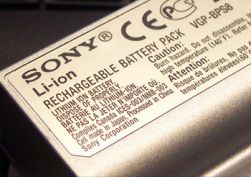Categories: Featured Articles » Sharing experience
Number of views: 36212
Comments on the article: 1
How to extend the life of lithium-ion batteries
How to extend the "life" of batteries and how to increase the number of charge / discharge cycles.
 Most of the devices around us use electrical energy to operate. In most cases, they completely lack an electric network, especially household appliances. But, in a situation with personal electronics and other portable devices, it’s necessary accumulator battery, which could provide the device with the right amount of energy outside the home.
Most of the devices around us use electrical energy to operate. In most cases, they completely lack an electric network, especially household appliances. But, in a situation with personal electronics and other portable devices, it’s necessary accumulator battery, which could provide the device with the right amount of energy outside the home.
For a long time, for the manufacture of batteries used technologies that have a number of disadvantages. But, starting in 1992, lithium batteries began to prevail in mass production (lithium ion and lithium polymer).
But, along with an increase in the number of functions in cameras, smartphones and tablets, the requirements for battery capacity have increased. And, the aesthetic preferences of most users force manufacturers to reduce the size of the batteries each time. Therefore, the battery life of many devices was reduced from 3 to 4 days to one day. But what can be done to extend the life of lithium batteries? We’ll talk about this today.
1. Use only original batteries with original devices. The fact is that increasing the voltage by only a few percent can halve the number of charge / discharge cycles. At the same time, even a slight decrease in the charging current can lead to incomplete charging of the battery. Of course, nothing bad will happen in this case. The battery will retain its capacity, but it will be unpleasant for you to find out about constant undercharging.
 2. Spend a full charge right after the first start. Manufacturers purposely charge batteries only 40 percent of their nominal capacity so that they do not lose in volume during transport. Therefore, immediately after switching on, connect Charger to the network and complete a full charge cycle. Also, do not believe the myths about the “24-hour charge for battery buildup”, modern devices independently stop the current supply when it reaches 100% capacity.
2. Spend a full charge right after the first start. Manufacturers purposely charge batteries only 40 percent of their nominal capacity so that they do not lose in volume during transport. Therefore, immediately after switching on, connect Charger to the network and complete a full charge cycle. Also, do not believe the myths about the “24-hour charge for battery buildup”, modern devices independently stop the current supply when it reaches 100% capacity.
3. Do not allow the device to operate at temperatures below -20 and above +30 on the Celsius scale. This can lead to battery failure. But, up to -18, the use of technology is almost harmless. The only thing you can notice is a faster discharge. And, for charging, you need to choose only the room where there is a comfortable plus temperature.
4. Do not allow a complete discharge. Many believe that it is optimal to use the battery "from and to." But, this is nothing more than a myth. Optimal will be continuous operation in the range from 10% to 90%. Yes, a full charge should also be avoided. However, doing this is a little more difficult, which means it is not worth recommending such a method as mandatory.
5. Store the batteries correctly. It would seem that it could be easier - he took out the battery and put it on the shelf. But, the fact is that with a full or zero charge, the capacity of the batteries will decrease with prolonged downtime. So, bring the charge indicator to a level of 40% and only after that can you safely pack the battery and put it in the refrigerator (only not in the freezer). Storage in such conditions will provide a long and "carefree" life to your little helper.
And finally, it’s worth saying that a careful attitude to your equipment will allow you to forget about breakdowns and problems in work.
Philip Ivanov
See also at bgv.electricianexp.com
:
